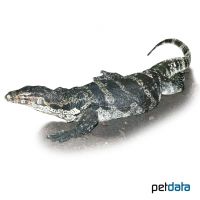Common Water Monitor (Varanus salvator)
| Common Water Monitor Varanus salvator | |
|---|---|
| Name | Common Water Monitor |
| Name Lat. | Varanus salvator |
| Family | Monitor Lizards |
| Family lat. | Varanidae |
| Order | Scaled Reptiles |
| Order lat. | Squamata |
| Origin | Asia |
| Habitat | Rainforests |
| Diet | Insects, small mammals, fish |
| Humidity | 60-80 % |
| Behavior | Semi-aggressive |
| Keeping | Individual, pair |
| Care Level | Experts only |
| Reproduction | Oviparous |
| Housing | Humid terrarium |
| Life Span | 12-15 years |
| Protection | CITES Appendix II; EU Annex B |
| Metric Units | |
| Size | 200 cm |
| Temperature | 25-30 °C |
| Temperature Local | 40-45 °C |
| Housing Size | 800 x 350 x 200 cm |
| US Units | |
| Size | 80" |
| Temperature | 77-86 °F |
| Temperature Local | 104-113 °F |
| Housing Size | 315" x 140" x 80" |
Distribution and habitat
The diurnal banded monitor lizards are widespread in Southeast Asia, from Sri Lanka to Bangladesh, Myanmar to Sumatra, Java and Borneo. They prefer to live in mangroves and rainforests, often near bodies of water, but also as cultural predators in plantations and settlements.
Maintenance
Minimum dimensions for the terrarium, according to the size and number of animals
| 1-2 animals | 5KRL x 2KRL x 2KRL (L x W x H) |
Head-torso length (KRL) is measured on the largest animal. For each additional animal, increase the footprint by 15%. A large terrarium of e.g. 800 x 350 x 200 cm is recommended, which should be placed in a quiet and vibration-free place.
They need a spacious terrarium structured with strong, horizontally mounted climbing branches and rock structures (hiding place and privacy screen), a deep graveable substrate of terrarium humus or a soil-peat mixture, and a large water basin suitable for bathing (ideally 30-40 cm deep) with a water temperature of about 25 °C. Part of the substrate should always be kept slightly moist. Several times a day, especially in the evening, the inside of the terrarium should be finely sprayed with water (humidity), but a rain or mist system is better.
| Temp. day: 25-30 °C | Temp. night: 20-24 °C | Temp. local: 40-45 °C | Humidity: 60-80 |
Thermostatically controlled floor heating is recommended. The lighting duration must be 10-12 hrs. They need high light intensity and daily UV irradiation as well as sunny places with radiant heat.
Diet
The predatory monitors eat everything they can overpower, but also carrion. The food supply consists of insects (crickets, grasshoppers, zophobas, etc.), small mammals, chicks, eggs (raw or cooked), fish, snails, etc., as well as meat from cattle and game, depending on their size. Commercially available ready-to-eat food is also readily accepted. Wax moths should rarely be fed in very small quantities because of their large fat content. It is important to add minerals and vitamins regularly (e.g. by dusting the feed). Young animals should be offered food daily, adults 3-4 times a week. Drinking water must always be available
A varied diet promotes health and prevents deficiency symptoms.
Reproduction and breeding
The sexes are difficult to distinguish. A reliable sex determination is only possible by x-rays or endoscopy.
The female lays 5-40 eggs in burrows she has dug herself. The incubation period is 170-320 days at a temperature of 30 °C. The young are 27-40 cm in size.
Life expectancy can be 12-15 years.
Species protection
The animal population must be reported in writing to the competent authority immediately after the start of keeping. Subsequently, all arrivals and departures must be reported.
Protection of species: WA Annex II; EU Annex B. The proof of purchase is the required proof of origin for the animal. Please keep it safe! Your pet store will be happy to provide you with further information.
Important
They need hiding places and, according to their need for warmth, sunny places with radiant heat, e.g. stones or branches irradiated with a spotlight. Young animals need more climbing opportunities. Males engage in comment fights at the beginning of the mating season.
Adults in particular tend to become obese, so an occasional period of fasting should be given. They are skilled climbers and excellent swimmers, also hunting in the water. In the large range there are several subspecies, which differ in coloration and markings. Six subspecies have been described so far.
The terrarium must have good ventilation without drafts and meet the species-specific needs. Measuring devices, such as thermometers, hygrometers, etc. are necessary. The lighting has to correspond to the species-specific day-night rhythm and has to be placed in such a way that the animals cannot injure themselves. The terrarium should be locked in such a way that neither unauthorized persons can open it nor the animals can escape. Contamination must be removed regularly.
Further literature can be found in your pet store.
References
Text: petdata; Image: petdata
Source: BMELV (1997): Tierschutzgutachten - Mindestanforderungen an die Haltung von Reptilien; ENGELMANN (2006): Zootierhaltung - Tiere in menschlicher Obhut: Reptilien und Amphibien, Harri Deutsch Verlag
- Gemäß § 21 Abs. 5 Tierschutzgesetz idgF
